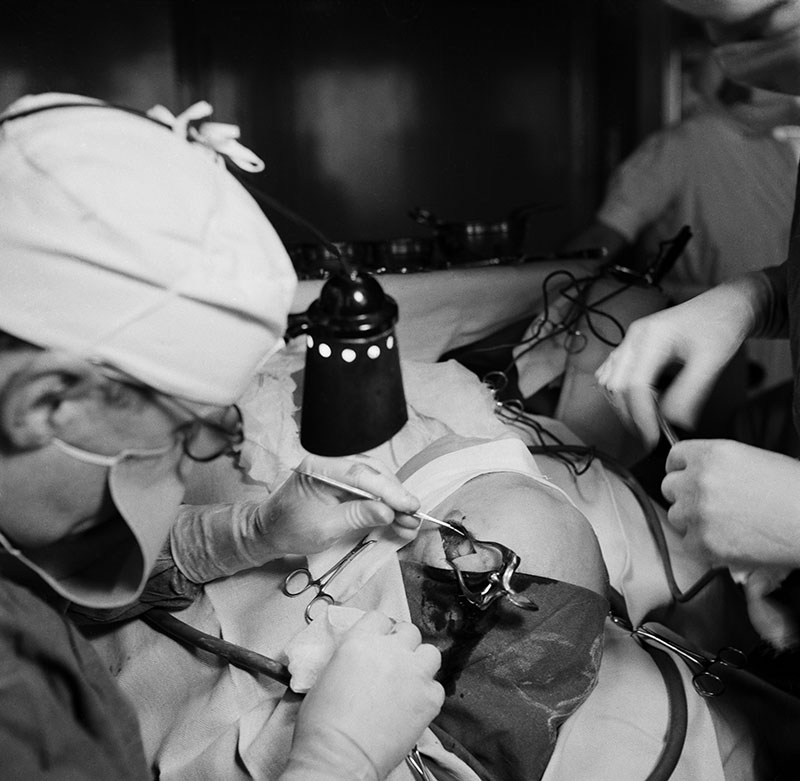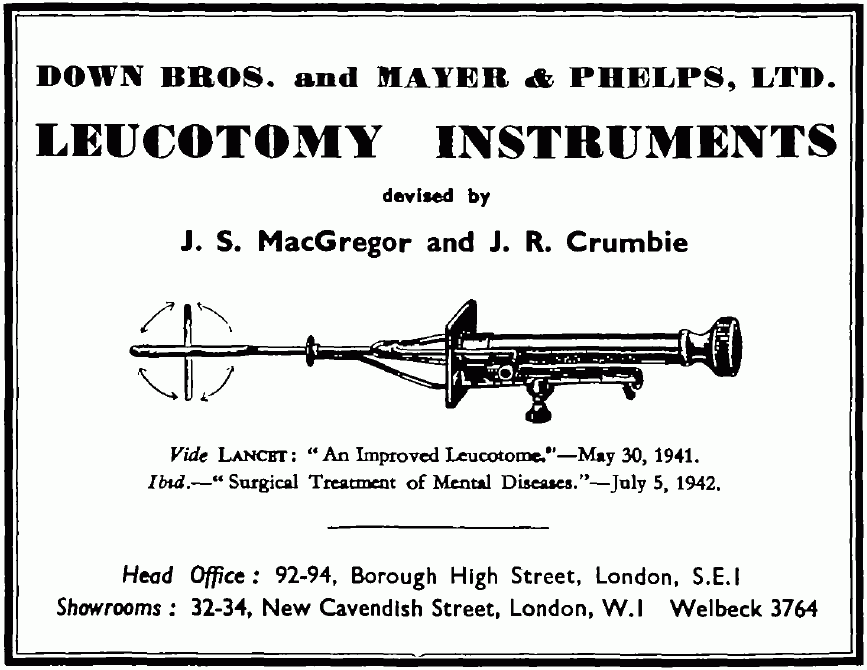|
Psychosurgery
Psychosurgery, also called neurosurgery for mental disorder (NMD), is the neurosurgical treatment of mental disorders. Psychosurgery has always been a controversial medical field. The modern history of psychosurgery begins in the 1880s under the Swiss psychiatrist Gottlieb Burckhardt. The first significant foray into psychosurgery in the 20th century was conducted by the Portuguese neurologist Egas Moniz who, during the mid-1930s, developed the operation known as leucotomy. The practice was enthusiastically taken up in the United States by the neuropsychiatrist Walter Freeman and the neurosurgeon James W. Watts who devised what became the standard prefrontal procedure and named their operative technique lobotomy, although the operation was called leucotomy in the United Kingdom. In spite of the award of the Nobel Prize to Moniz in 1949, the use of psychosurgery declined during the 1950s. By the 1970s the standard Freeman-Watts type of operation was very rare, but other f ... [...More Info...] [...Related Items...] OR: [Wikipedia] [Google] [Baidu] |
History Of Psychosurgery
Psychosurgery, also called neurosurgery for mental disorder or functional neurosurgery, is surgery in which brain tissue is destroyed with the aim of alleviating the symptoms of mental disorder. It was first used in modern times by Gottlieb Burckhardt in 1891, but only in a few isolated instances, not becoming more widely used until the 1930s following the work of Portuguese neurologist António Egas Moniz. The 1940s was the decade when psychosurgery was most popular, largely due to the efforts of American neurologist Walter Jackson Freeman II, Walter Freeman; its use has been declining since then. Freeman's particular form of psychosurgery, the lobotomy, was last used in the 1970s, but other forms of psychosurgery, such as the Bilateral cingulotomy, cingulotomy and capsulotomy have survived. Early history Trepanning, the practice of drilling holes in the skull, was performed from prehistoric times to the early Middle Ages and then again during the Renaissance. There is speculation ... [...More Info...] [...Related Items...] OR: [Wikipedia] [Google] [Baidu] |
Subcaudate Tractotomy
Psychosurgery is a surgical operation that destroys brain tissue in order to alleviate the symptoms of mental disorder. The lesions are usually, but not always, made in the frontal lobes. Tissue may be destroyed by cutting, burning, freezing, electric current or radiation. The first systematic attempt at psychosurgery is commonly attributed to the Swiss psychiatrist Gottlieb Burckhardt who operated on six patients in 1888. In 1889 Thomas Claye Shaw reported mental improvement in a case of General Paralysis of the Insane after a neurosurgical intervention. This led to a lively debate in the ''British Medical Journal'' on the usefulness of neurosurgery for the treatment of insanity. In the 1930s the Portuguese neurologist Egas Moniz developed a surgical technique for the treatment of mental illness and called it "leucotomy" or "psychosurgery".Z Kotowicz 2005 Gottlieb Burckhardt and Egas Moniz – Two Beginnings of Psychosurgery. ''Gesnerus'' 62: 77–101. Moniz' technique was adapt ... [...More Info...] [...Related Items...] OR: [Wikipedia] [Google] [Baidu] |
Leucotomy
A lobotomy () or leucotomy is a discredited form of neurosurgical treatment for psychiatric disorder or neurological disorder (e.g. epilepsy, depression) that involves severing connections in the brain's prefrontal cortex. The surgery causes most of the connections to and from the prefrontal cortex, the anterior part of the frontal lobes of the brain, to be severed. In the past, this treatment was used for handling psychiatric disorders as a mainstream procedure in some countries. The procedure was controversial from its initial use, in part due to a lack of recognition of the severity and chronicity of severe and enduring psychiatric illnesses, so it was said to be an inappropriate treatment. The originator of the procedure, Portuguese neurologist António Egas Moniz, shared the Nobel Prize for Physiology or Medicine of 1949 for the "discovery of the therapeutic value of leucotomy in certain psychoses", although the awarding of the prize has been subject to controversy. A ... [...More Info...] [...Related Items...] OR: [Wikipedia] [Google] [Baidu] |
Lobotomy
A lobotomy () or leucotomy is a discredited form of Neurosurgery, neurosurgical treatment for mental disorder, psychiatric disorder or neurological disorder (e.g. epilepsy, Depression in childhood and adolescence, depression) that involves severing connections in the brain's prefrontal cortex. The surgery causes most of the connections to and from the prefrontal cortex, the anterior part of the frontal lobes of the human brain, brain, to be severed. In the past, this treatment was used for handling mental disorder, psychiatric disorders as a mainstream procedure in some countries. The procedure was controversial from its initial use, in part due to a lack of recognition of the severity and chronicity of severe and enduring Mental disorder, psychiatric illnesses, so it was said to be an inappropriate treatment. The originator of the procedure, Portuguese neurologist António Egas Moniz, shared the Nobel Prize for Physiology or Medicine of 1949 for the "discovery of the therapeu ... [...More Info...] [...Related Items...] OR: [Wikipedia] [Google] [Baidu] |
Gottlieb Burckhardt
Johann Gottlieb Burckhardt (24 December 1836 – 6 February 1907) was a Swiss psychiatrist and the medical director of a small mental hospital in the Swiss canton of Neuchâtel. He is commonly regarded as having performed the first modern psychosurgical operation. Born in Basel, Switzerland, he trained as doctor at the Universities of Basel, Göttingen and Berlin, receiving his medical doctorate in 1860. In the same year he took up a teaching post in the University of Basel and established a private practice in his hometown. He married in 1863 but the following year he was diagnosed with tuberculosis and gave up his practice and relocated to a region south of the Pyrenees in search of a cure. By 1866 he had made a full recovery and returned to Basel with the intention of devoting himself to the study of nervous diseases and their treatment. In 1875, he attained a post at the Waldau University Psychiatric Clinic in Bern, and from 1876 he lectured on mental diseases at the Universit ... [...More Info...] [...Related Items...] OR: [Wikipedia] [Google] [Baidu] |
Walter Jackson Freeman II
Walter Jackson Freeman II (November 14, 1895 – May 31, 1972) was an American physician who specialized in lobotomy. Wanting to simplify lobotomies so that it could be carried out by psychiatrists in psychiatric hospitals, where there were often no operating rooms, surgeons, or anesthesia and limited budgets, Freeman invented a transorbital lobotomy procedure. The transorbital approach involved placing an orbitoclast (an instrument resembling an ice pick) under the eyelid and against the top of the eye socket; a mallet was then used to drive the orbitoclast through the thin layer of bone and into the brain. Freeman's transorbital lobotomy method did not require a neurosurgeon and could be performed outside of an operating room, often by untrained psychiatrists without the use of anesthesia by using electroconvulsive therapy to induce seizure and unconsciousness. In 1947, Freeman's partner James W. Watts ended their partnership because Watts was disgusted by Freeman's modificat ... [...More Info...] [...Related Items...] OR: [Wikipedia] [Google] [Baidu] |
António Egas Moniz
António Caetano de Abreu Freire Egas Moniz (29 November 1874 – 13 December 1955), known as Egas Moniz (), was a Portuguese neurologist and the developer of cerebral angiography. He is regarded as one of the founders of modern psychosurgery, having developed the surgical procedure ''leucotomy''better known today as ''lobotomy''for which he became the first Portuguese national to receive a Nobel Prize in 1949 (shared with Walter Rudolf Hess). He held academic positions, wrote many medical articles and also served in several legislative and diplomatic posts in the Portuguese government. In 1911, he became professor of neurology in Lisbon until his retirement in 1944. Early life and training Moniz was born in Avanca, Estarreja, Portugal, as António Caetano de Abreu Freire de Resende. He attended Escola do Padre José Ramos and the Society of Jesus, Jesuit-run :pt:Colégio de São Fiel, College of Saint Fidelis and studied medicine at the University of Coimbra, graduating in 1 ... [...More Info...] [...Related Items...] OR: [Wikipedia] [Google] [Baidu] |
Bilateral Cingulotomy
Bilateral cingulotomy is a form of psychosurgery, introduced in 1948 as an alternative to lobotomy. Today, it is mainly used in the treatment of depression and obsessive-compulsive disorder. In the early years of the twenty-first century, it was used in Russia to treat addiction.A. Carter and W. Hall 2012 ''Addiction neuroethics: the promises and perils of neuroscience research on addiction''. Cambridge University Press: 188-9. It is also used in the treatment of chronic pain. The objective of this procedure is the severing of the supracallosal fibres of the cingulum bundle, which pass through the anterior cingulate gyrus. History Cingulotomy was introduced in the 1940s as an alternative to standard pre-frontal leucotomy/lobotomy in the hope of alleviating symptoms of mental illness whilst reducing the undesirable effects of the standard operation (personality changes, etc.). It was suggested by American physiologist John Farquhar Fulton who, at a meeting of the Society of ... [...More Info...] [...Related Items...] OR: [Wikipedia] [Google] [Baidu] |
Neurosurgery
Neurosurgery or neurological surgery, known in common parlance as brain surgery, is the specialty (medicine), medical specialty that focuses on the surgical treatment or rehabilitation of disorders which affect any portion of the nervous system including the Human brain, brain, spinal cord, peripheral nervous system, and cerebrovascular system. Neurosurgery as a medical specialty also includes non-surgical management of some neurological conditions. Education and context In different countries, there are different requirements for an individual to legally practice neurosurgery, and there are varying methods through which they must be educated. In most countries, neurosurgeon training requires a minimum period of seven years after graduating from medical school. United Kingdom In the United Kingdom, students must gain entry into medical school. The MBBS qualification (Bachelor of Medicine, Bachelor of Surgery) takes four to six years depending on the student's route. The newly qu ... [...More Info...] [...Related Items...] OR: [Wikipedia] [Google] [Baidu] |
Schizophrenia
Schizophrenia () is a mental disorder characterized variously by hallucinations (typically, Auditory hallucination#Schizophrenia, hearing voices), delusions, thought disorder, disorganized thinking and behavior, and Reduced affect display, flat or inappropriate affect. Symptoms Prodrome, develop gradually and typically begin during young adulthood and rarely resolve. There is no objective diagnostic test; diagnosis is based on observed behavior, a psychiatric history that includes the person's reported experiences, and reports of others familiar with the person. For a diagnosis of schizophrenia, the described symptoms need to have been present for at least six months (according to the DSM-5) or one month (according to the ICD-11). Many people with schizophrenia have other mental disorders, especially mood disorder, mood, anxiety disorder, anxiety, and substance use disorders, substance use disorders, as well as obsessive–compulsive disorder (OCD). About 0.3% to 0.7% of peo ... [...More Info...] [...Related Items...] OR: [Wikipedia] [Google] [Baidu] |
Limbic System
The limbic system, also known as the paleomammalian cortex, is a set of brain structures located on both sides of the thalamus, immediately beneath the medial temporal lobe of the cerebrum primarily in the forebrain.Schacter, Daniel L. 2012. ''Psychology''.sec. 3.20 Its various components support a variety of functions including emotion, behavior, long-term memory, and olfaction. The limbic system is involved in lower order emotional processing of input from sensory systems and consists of the amygdala, mammillary bodies, stria medullaris, central gray and dorsal and ventral nuclei of Gudden. This processed information is often relayed to a collection of structures from the telencephalon, diencephalon, and mesencephalon, including the prefrontal cortex, cingulate gyrus, limbic thalamus, hippocampus including the parahippocampal gyrus and subiculum, nucleus accumbens (limbic striatum), anterior hypothalamus, ventral tegmental area, midbrain raphe nuclei, habenular commi ... [...More Info...] [...Related Items...] OR: [Wikipedia] [Google] [Baidu] |








